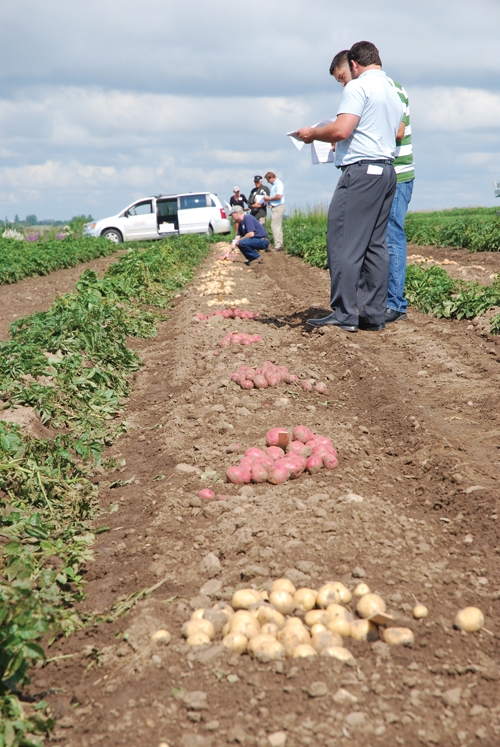
Features
Agronomy
Traits and Genetics
Developing varieties better suited to Ontario
In order to better compete, the Ontario potato industry is keen to have more breeding selection conducted in the province, and prospects for this to be realized are looking bright indeed. “The interest level for this is very strong,” notes Glen Squirrell, current chairperson at the Ontario Potato Board.
June 17, 2013 By Treena Hein
 Conditions in Ontario vary sufficiently for researchers to bring the process of varietal development closer to home at an earlier stage. In order to better compete
Conditions in Ontario vary sufficiently for researchers to bring the process of varietal development closer to home at an earlier stage. In order to better compete“The global potato industry is changing very quickly. Markets are becoming more focused on potatoes with special qualities such as low-glycemic index and coloured varieties with high levels of antioxidants. In order to meet the challenges coming from around the world, we need to have varieties that are well adapted to our growing conditions here and meet consumer needs.”
The University of Guelph’s potato breeding program was severely cut back more than 10 years ago, notes Squirrell. He believes support for it was cut when the main breeder retired. “It was very successful, producing the Yukon Gold variety, for instance,” he says.
While Squirrell acknowledges that there is one private breeding program in Ontario (at Sunrise Produce), “we are very supportive of having the University of Guelph’s program built back up again.” As it stands, Agriculture and Agri-Food Canada (AAFC) only provides that institution with funding to test varieties at their final stage of development, basically just before they are selected for commercial production and availability to growers.
Leading the charge to have Ontario potato breeding move “further upstream” in the testing process is Dr. Al Sullivan, a professor in the Department of Plant Agriculture at the University of Guelph. He and his lab technician Vanessa Currie have been involved with the AAFC testing program for about 11 years. “The material we currently receive is at the Elite breeding level,” explains Sullivan. “It has been tested for adaptation in various locations across the country and those lines that have done well are sent to us for evaluation in the Ontario environment.”
Sullivan would like to work with material that is “further up the selection pipeline,” so to speak. “We will be able to examine earlier generation material from the AAFC breeding centres in Fredericton, New Brunswick, and Lethbridge, Alberta, with the goal of strengthening the development pipeline for growers here,” he says. “Working with a much broader range of germplasm means selecting from a larger pool of genetic variability to better address Ontario’s market and growing conditions.”
The commercial uptake of AAFC-produced-lines by Ontario growers has been poor because the lines have not delivered well on either of these fronts. “The climate and soils are very different here than the Maritimes or Prairies,” says Sullivan. “It’s a much warmer and more humid climate here than Western or Atlantic Canada, and we have a longer growing season.” He adds, “Whether or not a given cultivar will grow here is not the issue. It’s about how well a cultivar performs and how the qualities of the lines manifest themselves in Ontario.”
Differences conditions, different needs
As with growing conditions, the markets in Ontario are also very different. “The potatoes in Fredericton and Lethbridge are developed with a strong emphasis towards the french-fry market,” notes Sullivan. “Here in Ontario, the markets are for chips as an end-product, and for table stock. In terms of potatoes that meet these demands, growers here haven’t found a great deal of value in the lines we’ve been evaluating.”
Growers have access to details about the lines from annual reports produced by Currie and Sullivan and distributed through the Ontario Potato Board, and can also view them first-hand during annual field days held in Guelph. “It’s therefore safe to say that growers have a fair amount of information about these selections that they can use when making their decisions,” says Sullivan.
As a plant breeder, Sullivan is ready, willing and able to get started. “Vanessa also provides a great deal of expertise,” he adds, “and the University of Guelph also brings the expertise of several other researchers and research labs to the table.”
A formal initial request to move forward was submitted to AAFC by Sullivan during fall of 2009. It included letters of support from growers, processors, major retailers, the Ontario Potato Board and the Canadian Snack Food Association.
The feedback on the request was positive, Sullivan says. He now has to submit the scientific request, and is already in the process of preparing and submitting funding applications. “AAFC has been very helpful in suggesting possible funding sources for this initiative, including the AAFC Science Cluster,” he says. “This will be a sizable up-scaling of our activities, and that will require a larger budget.”
Sullivan stresses, however, that not just any funding will do. “Success will require ongoing funding,” he notes.
“That may be a challenge to secure. Some of the programs we’re applying to provide one-time funding, which is a good start, but we need long-term financial support. The funding scientific review panels must decide if this is deserving of a higher priority than other ventures they may be evaluating.”
For his part, Squirrell is delighted with how things are progressing. “Growers have a huge interest in using varieties that are better suited to Ontario,” he concludes. “We’re very excited about the steps that have been taken so far on this and look forward to achieving this goal.”
Print this page